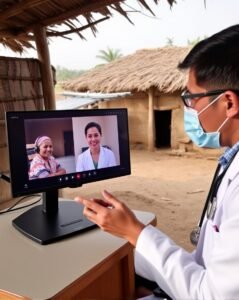From AI Innovations to Global Accessibility: How 2024 is Shaping the Future of Medicine
The year 2024 has emerged as a watershed moment in healthcare, marking unprecedented advancements in telemedicine and virtual care. These technologies are not only transforming patient experiences but are also bridging gaps in healthcare accessibility, especially for the underserved and needy populations around the world.
The AI Revolution in Healthcare
Artificial Intelligence (AI) has become a cornerstone in modern medicine, offering solutions that were once considered the realm of science fiction.
Key Highlights:
• Pattern Recognition and Context Understanding: AI’s ability to analyze complex medical data enables early detection of diseases and personalized treatment plans.
• Preventing Bias and Reducing Inequalities: Efforts are underway to ensure AI algorithms are free from biases that could exacerbate health disparities.
• Balancing Innovation with Regulation: Striking the right balance between rapid technological advancements and regulatory frameworks is crucial for patient safety.
Telemedicine Takes Center Stage
Telemedicine has evolved from a niche service to a mainstream method of delivering healthcare.
Advancements in 2024:
• Enhanced Connectivity: Improved global internet infrastructure has made virtual consultations more accessible, even in remote areas.
• Integration with AI: Combining telemedicine with AI diagnostics improves accuracy and efficiency in patient care.
• Expanded Services: From general consultations to specialized care, telemedicine now covers a broad spectrum of medical services.
Success Stories Highlighting the Impact
AI in Ophthalmology: Preventing Blindness Globally
In Portugal, the Screening and Eye Examination using AI Resources (SEER) project is making significant strides in combating preventable blindness.
• Target Diseases: Focusing on glaucoma and diabetic retinopathy, leading causes of blindness.
• AI-Assisted Retinal Imaging: Allows for rapid screening and identification of at-risk patients without the immediate need for specialist intervention.
• Scalable Solutions: The technology triples screening capacity and reduces unnecessary doctor visits by over 90%.
Future Impact: Over the next 15 years, SEER aims to prevent half of all blindness cases in the region, showcasing the profound potential of AI in preventive healthcare.
Streamlining Hospital Operations in Singapore
The National University Hospital in Singapore (NUHS) demonstrates how AI and telemedicine enhance operational efficiency.
• High Life Expectancy with Low Costs: Singapore’s healthcare system excels due to strategic investments and long-term planning.
• AI-Powered Tools:
• Chatbots: Provide patients with immediate assistance and information.
• Virtual Care Platforms: Reduce administrative burdens and improve patient access to care.
• “SerenityBot”: An AI tool aiding clinicians in making informed decisions based on the latest cancer care guidelines, ensuring that while AI supports, clinicians retain ultimate responsibility for patient outcomes.
Strategic Vision: Emphasizing that robust data infrastructure and governance are essential to fully leverage AI’s capabilities while maintaining patient trust and safety.
Scaling AI Solutions for Maximum Impact
At HCA Healthcare, Dr. Michael Schlosser emphasizes the importance of scaling AI applications to transform healthcare meaningfully.
• Defined Vision and Strategy: Clear goals guide the effective implementation of AI technologies.
• User-Centric Development: Involving healthcare workers in the development process ensures the solutions meet real-world needs.
• Measuring Impact: Continuous evaluation to ensure AI tools deliver measurable improvements in patient care.
• Reducing Administrative Burdens: Automating tasks like nurse handoffs improves efficiency and allows healthcare professionals to focus more on patient care.
The Future Possibilities: Benefiting the Needy
As we look ahead, several promising developments in telemedicine and virtual care have the potential to significantly benefit underserved populations.
1. Global Accessibility to Specialists
• Breaking Geographic Barriers: Patients in remote areas can consult specialists located anywhere in the world.
• Mobile Health Units: Equipped with telemedicine capabilities, these units bring advanced care to isolated communities.
2. Cost-Effective Healthcare Solutions
• Reducing Expenses: Telemedicine lowers costs associated with travel, hospital stays, and in-person consultations.
• Preventive Care Focus: Early detection and management of diseases reduce long-term healthcare expenses for patients and systems.
3. Personalized Medicine
• AI-Driven Treatment Plans: Customized care based on individual patient data leads to better outcomes.
• Continuous Monitoring: Wearable devices and remote monitoring tools allow for real-time health tracking.
4. Addressing Workforce Shortages
• Alleviating Clinician Burnout: Automation of administrative tasks reduces workload on healthcare professionals.
• Training and Support: Virtual platforms provide ongoing education and support for healthcare workers in underserved areas.
5. Enhanced Patient Engagement
• Interactive Platforms: Patients have greater access to their health information and can actively participate in their care.
• Language and Cultural Barriers: AI translation services ensure effective communication between patients and providers.
Challenges and Considerations
While the advancements are promising, certain challenges need to be addressed to maximize the benefits of telemedicine and virtual care.
• Digital Divide: Ensuring equitable access to technology and the internet is crucial.
• Data Security and Privacy: Robust measures are necessary to protect sensitive patient information.
• Regulatory Compliance: Navigating different regulations across regions requires careful planning.
Conclusion: Embracing a New Era in Healthcare
The advancements in telemedicine and virtual care in 2024 signify a transformative period in healthcare history. By harnessing AI and innovative technologies, we are making strides toward a more inclusive, efficient, and patient-centered healthcare system.
The Road Ahead:
• Collaboration is Key: Partnerships between healthcare providers, technology companies, and governments are essential.
• Continuous Innovation: Ongoing research and development will further enhance the capabilities of telemedicine.
• Focus on the Needy: Prioritizing solutions that address the needs of underserved populations will lead to global health improvements.
Join the Movement
The revolution in telemedicine and virtual care is here. Whether you’re a healthcare professional, patient, or tech enthusiast, your involvement can shape the future of global health.
Share Your Thoughts: How do you envision telemedicine impacting your community? What challenges do you foresee, and how can we overcome them? Let’s discuss!

Stay Informed
Subscribe to our newsletter for the latest updates on telemedicine, virtual care, and healthcare innovations.











